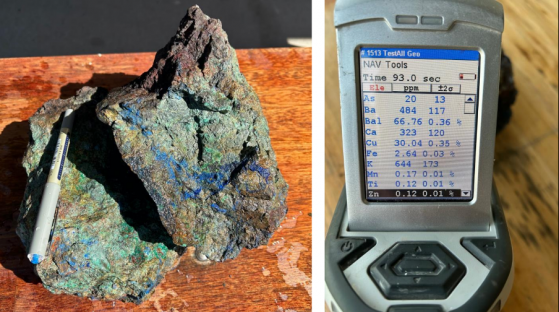QMines Ltd (ASX:QML) is honing in on high-grade copper in azurite- and malachite-bearing structures at its cornerstone Mt Chalmers Copper-Gold Project in central Queensland.
Ground truthing over an electromagnetic target led the explorer to strong base metal anomalism, with early-stage pXRF analysis returning up to 30.04% copper in gossans and 23.48% in quartz breccia.
Azurite and malachite — discovered at the Tracker 1 prospect — are often found in sulphide copper deposits. As such QMines’ believes these pathfinder minerals hint at discovery upside in Mt Chalmers’ historical prospecting pits.
The initial results give new impetus to the explorer’s upcoming drill program, which will kick off once it finalises land access agreements over priority electromagnetic targets.
Oxidised gossan with supergene copper (azurite/malachite) at the T1 prospect.
Compelling targets in the crosshairs
QMines managing director Andrew Sparke is excited to hit the ground running in the coming weeks.
"Once drilling is completed at the Mt Chalmers west pit, chasing resource extensions, the rig will start to test multiple electromagnetic anomalies generated from the recent survey,” he explained.
"The first of those will be at Tracker 1, where the company has discovered visible copper mineralisation up to 30.04% copper in old workings.
“With a large drilling program planned and a number of compelling targets to test, it is bound to be an exciting field season for our shareholders.”
All eyes on Tracker 1
QMines has spent the better part of 18 months collating and digitising all available historical data for Mt Chalmers’s regional targets, including soil geochemistry, rock chip sampling, geological mapping and structural geological interpretations.
All of this information has been broken down into regional areas known as Tracker 1 (T1), Tracker 2 (T2), Tracker 3 (T3), Mt Chalmers and Striker.
T1 remains the current focus, as a number of priority electromagnetic targets have been identified in this area.
That’s because pockets of anomalous copper and zinc in soils, high-grade rock chips, mapped gossan and structural trends have emerged across the T1 prospect, with the latest field assessment only proving up its copper prospectivity.
T1 target areas.
What’s to come?
Before work gets underway at Mt Chalmers’ electromagnetic targets, QMines plans to wrap up resource and infill drilling in the west pit.
From there, it will deliver final metallurgical test-work and an initial treatment plant flow sheet for the foundational Mt Chalmers deposit, which will underpin stage two of a pit optimisation study.
The revised optimisation plan will include the new-and-improved metallurgical recoveries and scope out an underground mining scenario.
Beyond the flagship deposit, QMines will adopt a regional focus, delivering the final results from its electromagnetic survey and firming up its priority target suite.
It hopes to set the drill bit spinning to identify new volcanic-hosted massive sulphide discoveries ahead of the Mt Chalmers pre-feasibility study.
Read more on Proactive Investors AU
